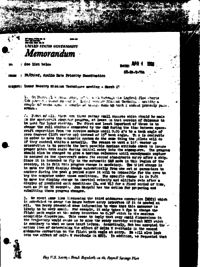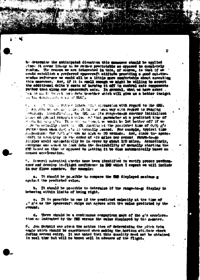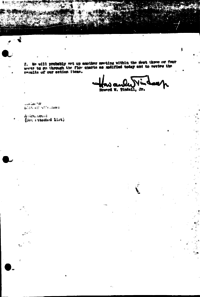Upthread: Lunar Reentry Mission Techniques meeting – March 7 (Mar 13, 1968)
Downthread: April 9 Lunar Reentry Mission Techniques meeting (Apr 17, 1968)
See list belowAPR 4 196868-PA-T-70APA/Chief, Apollo Data Priority CoordinationLunar Reentry Mission Techniques meeting – March 21
1. On March 21 a small group of us ???? ??????? the logical flow charts TRW produced based on our ??? Lunar Reentry Mission Techniques meeting a couple of weeks ago. A couple of things came up that I should probably pass around.
2. First of all, there are three rather small changes which should be made in the spacecraft computer program, at least in that version of Colossus to be used for lunar reentry. The first and least important of these is to change the roll attitude commanded by the G&N during the time between space- craft separation from the service module until 0.05 g's to a bank angle of zero degrees (lift vector up) instead of 15° bank angle. This is desirable in order to make the automatic system do the same thing the pilots will do if they control attitude manually. The reason we want a lift vector up orientation is to provide the best possible horizon attitude check to insure proper pitch trim angle during initial entry into the atmosphere. The program should also be changes to give a horizon reference until aerodynamic capture is assured as the spacecraft makes its second atmospheric entry after a skip. Since it is intended to fly in the automatic G&N mode in this region of the reentry, it is felt this program change is mandatory. The third change is to make the DSKY display change automatically from one set of parameters to another during the peak g period since it will be impossible for the crew to key the computer under those conditions. The specific change is in P-65 to make the display change to inertial velocity and altitude rate after a display of predicted exit conditions (DL and VL) for a fixed period of time, such as 20 or 30 seconds. Jon Harpold has the action for preparing and submitting these program changes.
3. We spent some time discussion the third midcourse correction (MCC3) which is scheduled to occur two hours before entry interface if it is needed at all. Ron Berry presented some information to show that this maneuver is likely to be very small. For example, it only takes 4 fps to change the flight path angle at the entry interface to 0.36° which is the maximum acceptable dispersion. This seems to imply that very small dispersions in the trajectory would cause us to miss the entry corridor without MCC3 which is contrary to what we have heard before. Accordingly, Ron has accepted the action item of determining the effect of delta V residuals in the second midcourse correction on the flight path angle at entry. He will also look into the effect of delta V residuals in MCC3. In addition, we requested that he determine the anticipated direction this maneuver should be applied since it seems likely to be rather predictable as opposed to completely random. The reason we are interested in this, or course, is that if we could establish a preferred spacecraft attitude providing a good out-the- window reference we would all be a little more comfortable about executing this maneuver. And, if it is small enough we might be willing to accept the additional delta V costs of burning it off in control axis components rather than along one spacecraft axis. In general, what we have asked Ron to do is to put some data together which will give us a better insight to the ???????????? as of MCC3.
4. ??????? had a rather interesting discussion with regard to the EMS. It appears we are s?????ing it in the best way with regard to ranging accuracy. Specifically, the EMS and its range-to-go counter initialized based on ground computed values of that parameter at a predicted time of reaching 0.05 g's. It seems as though we would be lot better off if we were to actually start the EMS running at the predicted time of 0.05 g's rather than when 0.05 g's is actually sensed. For example, typical time dispersions for 0.05 g's are as high as 20 seconds. And, since the space- craft is traveling in the order of six miles per second, range-to-go display would automatically be in error by about 120 miles. Accordingly, everyone was asked to look into the desirability of manually starting the EMS based on time as opposed to letting it be done automatically based on sensed acceleration.
5. Several potential checks have been identified to verify proper perform- ance and develop in-flight confidence in EMS which I expect we will include in our flows somehow. For example:
a. It should be possible to compare the EMS displayed maximum g against the predicted value.
b. It should be possible to determine if the range-to-go display is behaving within limits of being right.
c. It is possible to see if the predicted velocity at the time of .2 g's as the spacecraft skips out agrees with the value predicted by the ground.
d. There should be a continuous comparison made of the g's accelera- tion as indicated by the EMS versus the value displayed by the g-meter.
6. Jon Harpold was given the action item of determining the pitch trim angle which should be experienced when making the horizon attitude check during second entry. It was noted that this quantity need not be obtained in real time but will be known well in advance of the flight.
7. We will probably set up another meeting within the next three or four weeks to go through the flow charts as modified today and to review the results of our action items.
- Mar 13, 1968 – Lunar Reentry Mission Techniques meeting – March 7 (8.4σ)
- Nov 21, 1968 – C’ entry initialization with no communication (7.2σ)
- Nov 20, 1968 – C’ Mission Techniques – mostly Entry (3.6σ)
- Jan 17, 1968 – Reentry from lunar missions (3.6σ)
- Feb 06, 1968 – Lunar Reentry Mission Techniques meeting (3.1σ)




